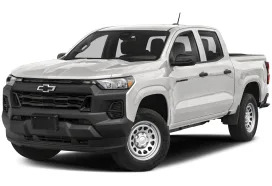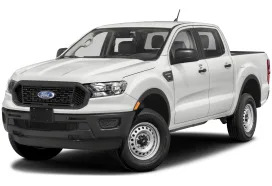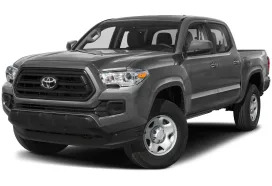Having already driven the 2023 Chevrolet Colorado Trail Boss extensively off-road in the course of our first drive review, it was time to get it back home and see how it deals with the mundanity of family life.
Of course, full-size pickups are in most cases the truck of choice for families given their crew cabs’ colossal backseat space and abundant available features. But midsize pickups aren’t exactly small, and with crew cabs of their own, it’s not like your kiddos will be riding in those frightful flip-down jump seats of old or, even more frightfully, just out in the bed with the German Shepherd.
If any midsize pickup is going to make the cut, it’s the all-new Colorado. Only the crossover Honda Ridgeline clearly surpasses its cabin space, while the Chevy's clean-sheet redesign results in a thoroughly modern cabin that stands in sharp contrast to the aged Toyota Tacoma and Ford Ranger. Even the recently updated Nissan Frontier makes do with the same compact dimensions as its ancient predecessor. Besides space, the Colorado also has the latest technology, including an 11.3-inch width-oriented touchscreen running the General’s Android Automotive-sourced interface, despite otherwise being outfitted like the base trim level. This, plus a compelling design, makes the cabin look, feel and function less like a bare-bones truck and more like a daily driver despite ample hard plastic.
In this road test, I’ll be breaking down how the Colorado performed in three specific daily driver chores: kid transport, weekend family outing and Lowe’s run. OK, so I did technically off-road for the above photo shoot, but as you can see, it didn't exactly get dirty.


The child seat test!
This is admittedly the first pickup I’ve installed my son’s Britax Boulevard into forward-facing, and therefore needed to secure the rear LATCH anchor. I do not know if the Colorado’s rear anchor setup is unique, but I know I’ve never seen it before in a full-size truck, and after some research can see that the Ford Ranger, Jeep Gladiator and Nissan Frontier have tethers accessed by flipping the seatback forward. The Colorado’s seatback is fixed. Instead, there is a hefty metal bracket on top of the seatback behind the middle head restraint. Should you choose to place the seat in one of the outboard positions (as is totally normal), you must do the following.
- Remove head restraint.
- Snake tether through a cloth loop attached to another hefty metal bracket.
- Bring tether over to middle metal bracket and snap it onto the bracket hole (there are two) closest to the seat.
- Tighten tether.
This last step was not easy. The window is so close that it was very difficult to pull the tether strap back to tighten it. My seat’s tether design is also shaped like a V with the tether clasp at the tip, making it even harder to tighten when pulling it over to the right instead of straight back. It took a lot of effort to make sure it was truly tight.

Definitely consult the owner’s manual and test to make sure there is no movement in the seat once you’ve secured it. Taking it to a certified child seat fitment specialist (fire departments are a good bet) is highly recommended.
Once finally secured, however, the seat fit just fine. I had to scoot the front seat forward so my son couldn’t kick my wife up front, but even then, she had sufficient room. This should not be an issue with better-behaved children / not toddlers. The door opening, cabin height and seat position also made it exceptionally easy to lift and secure my son into his seat – easier in fact than most compact family crossovers.
Another element worth noting is that the Colorado’s back seat bottom is split 60/40. With it, you can still take advantage of the under-seat storage (I used it to stash my laptop) or the extra space for luggage without needing to remove the child seat. You can’t do that in the Ford Ranger, which has a one-piece seat bottom.

Beach day!
Having a truck seemed like a good way to visit the beach without ending up with a trunk full of sand. Instead of carefully packing our Niro with the fold-up beach wagon and chairs, towels, toy bucket, etc., I just chucked it all in the Colorado’s bed. OK, so I did position it all so the heavy wagon wouldn’t ping-pong around the bed, but still, a lot easier than an SUV.
That positioning was made easier by the fact the Colorado is a midsize truck. It’s easier to reach over the bed sides without needing to climb up and down a bunch of times. Had I needed to, there are corner steps, though it sure would be nice if GM could come up with a MultiPro Jr. for the Canyorado. Coloranyon? Whatever.
More impressive than successfully fitting a small amount of beach gear in a pickup bed (duh), was the way the Colorado performed on the way to the beach. You see, the drive to Malibu from my home in the Conejo Valley requires a trip down the long, winding, high-speed Kanan Road. The Colorado’s smaller size was certainly appreciated, as I was able to maintain a speedy clip through the various corners and pass achingly slow-going traffic on the three-lane portions. The steering is pleasingly weighted and reassuringly responsive.

The most impressive element, however, was the eight-speed automatic transmission. Kanan features multiple grades, the most severe of which is 8%. On all of them, prolonged brake application would automatically cue a downshift that was sustained for the length of the grade. This, my friends, is called grade logic. No need to tap the +/- toggle on the shifter or select some L mode. The truck smartly and smoothly does it for you, thereby using engine braking to slow the car rather than riding (and cooking) the brakes. This is ultimately best appreciated while towing, but that doesn’t mean it can’t come in handy in other scenarios.
As for the 2.7-liter turbocharged inline-four, this truck has the middle-ground tune of 310 horsepower and 390 pound-feet of torque. There was absolutely no problem coming back up those grades, as that is an ample amount of oomph for a truck this size. It also sounds OK despite having four fewer cylinders than so many pickup owners expect (though like every GM 2.7 turbo, the diesel-like wastegate whoosh can still be heard at lower speeds every time you toe the throttle).
Fuel economy, however, wasn’t as good as you might expect for a smaller truck. I drove the Colorado a total of 170 miles in suburban, highway and, yes, a winding high-speed canyon road. The result was 16.8 mpg. That’s pretty close to the EPA estimates of 17 mpg city, 19 mpg highway and 18 mpg combined when fitted with the mud-terrain tires of this Trail Boss. The least-efficient Silverado with this engine gets 19 mpg combined, although the EPA doesn’t specify what the Silverado Trail Boss would get with its mud-terrain tires. Still, if you were expecting gas savings with a midsize truck, you’ll be disappointed.


Hauling bags of poo!
I used the presence of a truck to kick off construction of a backyard rock patio. While the 190 cubic-feet of rock itself would exceed the Colorado’s payload (I was really pushing it when I did something similar with an F-150), everything else needed for the job could be loaded with ease in the bed. I know I wouldn’t have been too keen on putting 12 bags of top soil/steer manure in an SUV, be it mine or a press vehicle, nor the cultivator that could certainly do a number on an interior’s plastic, carpet or upholstery. The wagon-style wheel barrow I purchased also would've been rather iffy in a lot of vehicles. Again, the bed’s load and side heights made lifting and arranging the various items easy.
Frankly, this is the type of use case I’d foresee many people needing a truck for – not towing a small house or having a ton of river rock dumped into its bed. It’s more about the versatility of a truck bed than the maximum weights and capacities. In this case, a full-size truck is overkill. A midsize one like the Colorado will do the job, while being easier to park in tight spots, maneuver on trails or handle a winding road. Oh, and be cheaper. This Trail Boss stickered for $41,055; a comparable Silverado Trail Boss would be $50,835 and still has the old, crappy GM truck interior with the small, non-Google touchscreen.
That said, fuel economy disappoints and there’s certainly no denying a full-size truck is better suited for loading kids in the back. The ride quality, while not objectionable for a truck, is also rougher than the full-sizers – there are more vibrations felt through the frame, solid rear axle and leaf springs. If you want a truck for road trips, a Silverado would be a better bet (a Ram would be even better). The Colorado is therefore better-suited to the more suburban-going truck owner, or indeed, those without kiddos.
Related video:
Chevrolet Colorado Information






Sign in to post
Please sign in to leave a comment.
Continue